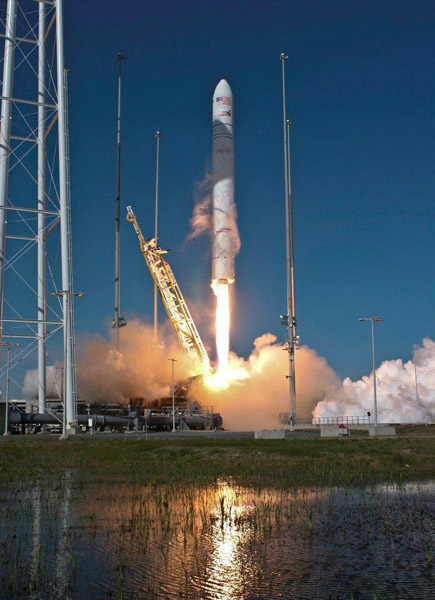Press-center
Press-center

LAUNCH OF MODERNIZED ANTARES LAUNCH VEHICLE WITH UKRAINIAN FIRST STAGE
On November 17, 2018, at 11:01 Kiev Time (04:01 North American Eastern Standard Time) from Wallops Flight Facility (Virginia, the USA) the ninth successful launch was made of modernized Antares launch vehicle which injected into orbit the Cygnus CRS NG-10E S.S. John Young cargo spaceship. It will deliver to the International Space Station (ISS) the equipment for the crew and for scientific experiments and backup equipment of total mass of 3450 kg.
The delivery is performed in several phases. After the separation from Antares LV, the Cygnus SC deploys its solar arrays and makes a series of ignitions of its propulsion system in order to raise orbit and approach to the ISS to the distance of about 4 km. After permission is obtained, Cygnus begins rendezvous with the ISS. When the distance between them is 12 meters, the ISS crew will perform docking using a robotized arm.
Approximately five weeks, Cygnus will stay docked to the ISS, then it will be undocked at the specified point of orbit and after a series of engine ignitions, it will depart to the distance safe for the ISS. After another two days, Cygnus will start the engine, enter dense atmosphere and safely destruct above the Pacific Ocean.
The Antares LV is a two-stage launch vehicle with the possibility of installing the third stage, designed to inject the payload with mass up to eight ton into low Earth orbits. The Antares LV was developed by Orbital-ATK which in June 2018 was acquired by Northrop Grumman.
Yuzhnoye SDO and Yuzhmash developed, manufactured and verified the Antares LV first stage core structure. Energomash NPO – first stage engines, Northrop Grumman – avionics, primary structure, testing, software, first stage integration, second stage engine, composite materials.
The Cygnus CRS NG-10E automatic cargo transport spaceship was named after John Young, a former NASA astronaut – one of 12 men who landed on the Moon. John Young made six space flights (including the first manned flight on Gemini spaceship, the second flight to the Moon’s orbit on Apollo 10 spaceship, the fifth lunar expedition on Apollo16 spaceship, the first flight on Space Shuttle space transport system), he was Director of NASA Astronauts Department 1974-1987, Assistant Director and Technical Director of NASA Johnson Space Center in 1987-2004.
Related posts
ACTIVITIES ARE UNDER WAY TO DEVELOP THE UKRAINIAN ARTILLERY MISSILES TAIFUN-1 FOR GRAD MULTIPLE ROCKET LAUNCHER SYSTEM
ANTARES LAUNCHES CYGNUS WITH CARGO FOR INTERNATIONAL SPACE STATION
OFFICIAL COMMENTS ON THE STATUS OF SICH -2-1 (SICH -2-30)
CONDOLENCES TO THE FAMILIES, FRIENDS AND FELLOW-SOLDIERS OF THE TRAGICALLY KILLED ON THE TERRITORY OF SE YUZHMASH AND SE YUZHNOYE SDO
https://fineline.uk.com/modelmaking/
https://yvonnedme.com/premier-bet-zone-mobile/
https://navesa.com.br/politica-de-privacidade/
https://novosolhares.ibase.br/
https://lyon.snuep.fr/category/mutations/intra/
https://cucgachcafe.com.vn/luong-minh-phuong-la-ai/
https://smartcount.ict.ihu.gr/
https://vivo500-joker-lonely17.pages.dev/
https://www.satisfactory.life/contacto/
https://www.booksarepopculture.com/
https://tunaskaryajakarta.sch.id/
https://www.visitasguiadastui.com/contacto/
https://www.vizgraphics.com/showcase/
https://jdi.ac.ug/application/
https://www.kiadesivo.com.br/contato/
https://www.kiadesivo.com.br/obrigada-pela-compra/
https://www.kiadesivo.com.br/politica-de-privacidade/
